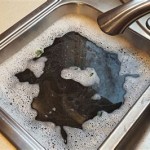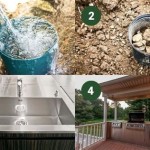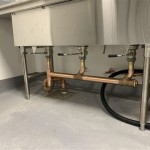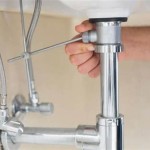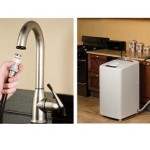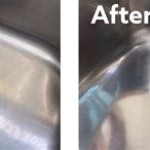Here's an article about unclogging sink drains using baking soda and vinegar, formatted as you requested:
Unclogging Sink Drains: A Guide to Baking Soda and Vinegar Method
A clogged sink drain is a common household problem. The accumulation of hair, grease, soap scum, and other debris can gradually restrict water flow, leading to a slow or completely blocked drain. While commercial drain cleaners are readily available, they often contain harsh chemicals that can damage pipes, pose environmental risks, and present potential health hazards. A safer and more environmentally friendly alternative is the use of baking soda and vinegar, a readily available and effective solution for many common sink clogs. This article provides a detailed guide on how to use baking soda and vinegar to unclog a sink drain, explaining the underlying chemical reaction and offering preventative measures to avoid future blockages.
The effectiveness of baking soda and vinegar in unclogging drains stems from a simple yet powerful chemical reaction. Baking soda, or sodium bicarbonate (NaHCO₃), is a mild alkali. Vinegar, typically a 5% solution of acetic acid (CH₃COOH) in water, is a weak acid. When these two substances are combined, they react to produce carbon dioxide gas (CO₂), water (H₂O), and sodium acetate (CH₃COONa). The carbon dioxide gas effervesces, creating bubbling and fizzing action that can help to dislodge and break down the materials causing the clog.
Understanding the Benefits of Baking Soda and Vinegar
The popularity of using baking soda and vinegar to unclog drains arises from several distinct advantages. First and foremost, it's a significantly safer alternative to harsh chemical drain cleaners. Commercial drain cleaners often contain strong acids or bases that can cause burns if they come into contact with skin or eyes. They can also corrode pipes, especially older metal pipes, leading to leaks and costly repairs. Baking soda and vinegar, on the other hand, are non-corrosive and generally safe to handle. While it's still advisable to wear gloves and eye protection, the risk of serious injury is significantly reduced.
Secondly, baking soda and vinegar are environmentally friendly. Chemical drain cleaners can release harmful substances into the wastewater system, potentially polluting waterways and harming aquatic life. Baking soda and vinegar are biodegradable and break down harmlessly in the environment. This makes them a responsible choice for homeowners concerned about their environmental impact.
Thirdly, baking soda and vinegar are cost-effective and readily available. Both ingredients are common household staples, typically found in the pantry. Compared to the price of commercial drain cleaners, which can be expensive, baking soda and vinegar offer a budget-friendly solution. The accessibility and affordability of these ingredients make them a convenient option for tackling sink clogs at any time.
Finally, the baking soda and vinegar method, while generally effective, can also serve as a preventative maintenance tool. Regularly flushing the drain with this solution can help to prevent the buildup of debris and keep the drain flowing freely. This proactive approach can save time and money in the long run by preventing more severe clogs from forming.
Step-by-Step Guide to Unclogging a Drain with Baking Soda and Vinegar
Before beginning the unclogging process, ensure the sink is partially empty. If the sink is completely full of standing water, use a cup or container to remove as much water as possible. This allows the baking soda and vinegar solution to reach the clog directly. Next, remove the drain stopper, if applicable. Some stoppers can be easily lifted out, while others require unscrewing or a slightly more complex removal process. Consult the sink's manual or search online for specific instructions if needed.
Once the sink is prepared, pour approximately one cup of baking soda down the drain. Try to pour it directly into the drain opening to ensure it reaches the clog. Follow the baking soda with one cup of vinegar. As the vinegar comes into contact with the baking soda, a fizzing reaction will occur. This is the carbon dioxide gas being released, working to break down the clog. Allow the mixture to sit and react for at least 30 minutes. For tougher clogs, allow the mixture to sit for a longer period, up to several hours, or even overnight.
After the waiting period, flush the drain with hot water. The hot water will help to further break down any remaining debris and flush it away. Run the hot water for several minutes, checking to see if the drain is flowing freely. If the drain is still slow or clogged, repeat the entire process. It may take several attempts to completely clear a stubborn clog. In cases where the clog persists after multiple attempts, the next steps may involve using a plunger or a drain snake.
If the baking soda and vinegar method does not fully resolve the clog, it may be necessary to use a plunger. Ensure there is enough water in the sink to cover the cup of the plunger. Create a tight seal around the drain opening with the plunger and push and pull vigorously for several minutes. Repeat this process several times. The pressure created by the plunger can often dislodge stubborn clogs.
Alternatively, a drain snake, also known as a plumber's snake, can be used to physically break up and remove the clog. Insert the drain snake into the drain opening and carefully feed it down the drainpipe. Rotate the snake as you push it down to help it navigate the bends in the pipe. When you encounter resistance, this indicates that you have reached the clog. Continue to rotate the snake to break up the clog. Once you feel the clog loosen, retract the snake and remove any debris that is attached to it. Flush the drain with hot water to remove any remaining debris.
Preventative Measures to Avoid Sink Clogs
Preventing sink clogs is often easier than resolving them. Several preventative measures can be taken to minimize the accumulation of debris and keep the drain flowing freely. One important step is to avoid pouring grease down the drain. Grease solidifies as it cools, coating the inside of the pipes and trapping other debris. Instead, pour grease into a container and dispose of it properly in the trash. Similarly, avoid flushing food scraps down the drain. Food particles can accumulate and contribute to clogs. Use a sink strainer to catch food scraps and dispose of them in the trash or compost.
Regularly flush the drain with hot water. Running hot water down the drain for a few minutes each week can help to dissolve any grease or soap scum that may be starting to accumulate. Consider using a drain strainer in all sink drains. These strainers catch hair, food particles, and other debris before they can enter the drainpipe. Clean the drain strainer regularly to prevent it from becoming clogged itself. Another preventative measure is to periodically flush the drain with a baking soda and vinegar solution. Doing this once a month can help to prevent clogs from forming in the first place.
Another useful tip is to avoid dropping small objects down the drain. Items such as jewelry, small toys, or bottle caps can easily become lodged in the drainpipe and cause a blockage. Be mindful of what is near the drain and take steps to prevent anything from falling in. Furthermore, for sinks that are prone to clogging, consider having a professional plumber inspect the drainpipes. A plumber can identify any potential problems, such as pipes that are improperly sloped or have accumulated excessive buildup. They can also provide recommendations for preventative maintenance.
By understanding the principles behind the baking soda and vinegar method, following the step-by-step guide, and implementing preventative measures, homeowners can effectively manage sink clogs and maintain a healthy plumbing system. The combination of safety, environmental friendliness, and cost-effectiveness makes this method a valuable tool for any homeowner.

Unclog Drains Naturally With Baking Soda And Vinegar Mom 4 Real

How To Clear A Clogged Sink Drain With Vinegar Baking Soda

How To Unclog A Drain With Baking Soda Vinegar The Art Of Manliness

How To Naturally Clean A Clogged Drain The Definitive Guide Bren Did

How To Unclog Your Kitchen Sink With Baking Soda And Vinegar It Works

Never Clear A Blocked Sink With Baking Soda And Vinegar Use This Instead Youtube

How To Clean Drains With Baking Soda And Vinegar Liquid Plumr

How To Unclog A Best Sink With Baking Soda

Why You Should Never Use Baking Soda And Vinegar To Clean Clogged Drains

Unclog Drains Naturally With Baking Soda And Vinegar Mom 4 Real
